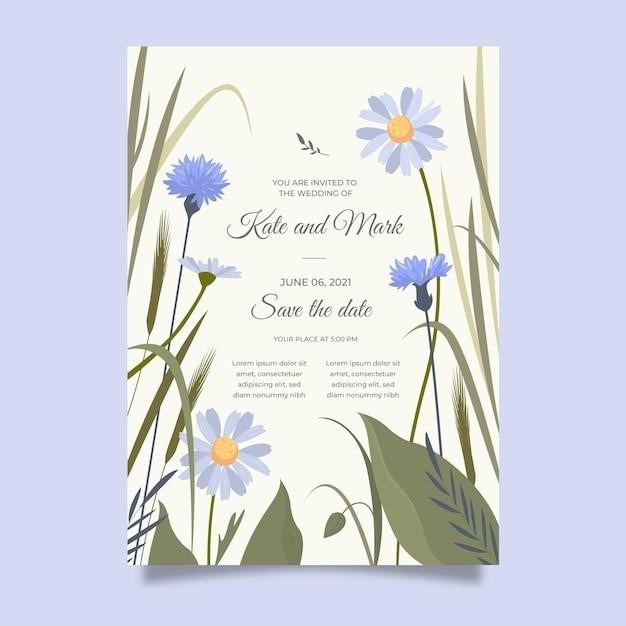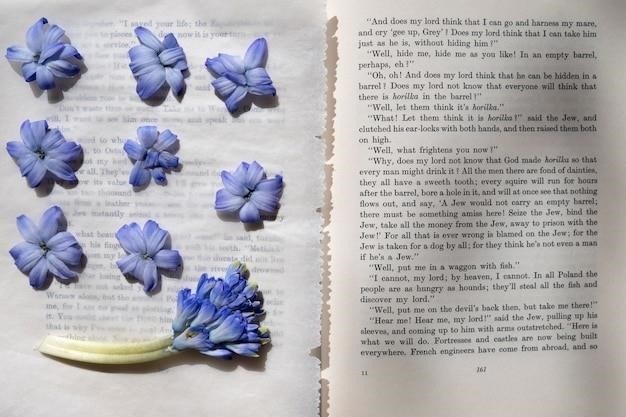
Maggie Nelson’s “Bluets”⁚ A Poetic Exploration of Blue
Maggie Nelson’s “Bluets” (2009) is a unique and evocative memoir that explores the complex and multifaceted nature of the color blue․ Written in numbered segments, the book delves into themes of depression, pain, desire, and heartbreak, using blue as a powerful metaphor for the full spectrum of human emotion․
A Unique and Evocative Memoir
Maggie Nelson’s “Bluets” is a captivating exploration of the color blue, presented in a unique and evocative format․ The book is structured as a series of numbered segments, each offering a distinct reflection on the multifaceted nature of blue․ It is a memoir, yet it transcends traditional boundaries, weaving together personal experiences, philosophical musings, and cultural observations, all filtered through the lens of this singular hue․ The result is a deeply intimate and intellectually stimulating work that delves into the complexities of human emotion, memory, and perception․
The Color Blue as a Metaphor for Human Emotion
Nelson utilizes blue as a potent metaphor to navigate the complexities of human emotion, particularly the more melancholic and introspective aspects․ From the deep blues of sorrow and despair to the lighter shades of longing and desire, blue becomes a canvas upon which Nelson paints her experiences of love, loss, and the search for meaning․ The color serves as a conduit for her exploration of the nuanced shades of human feeling, allowing her to delve into the depths of her own emotional landscape and connect with the shared human experience of vulnerability and complexity․
Themes of Depression, Pain, Desire, and Heartbreak
Nelson’s “Bluets” confronts the raw and often painful realities of human experience, particularly those associated with depression, heartbreak, and the yearning for connection․ The book explores the cyclical nature of desire and its potential for both joy and suffering․ Nelson delves into the complexities of loss, the profound impact of grief, and the persistent ache of unfulfilled longing․ Through her exploration of these themes, she challenges readers to confront their own vulnerabilities and to acknowledge the inherent fragility of human relationships․ “Bluets” serves as a poignant reminder that even in the darkest moments, there is beauty to be found in the shared human experience of pain and resilience․
Nelson’s Writing Style⁚ A Blend of Poetry and Prose
Maggie Nelson’s writing in “Bluets” defies easy categorization, seamlessly blending the lyrical beauty of poetry with the analytical depth of prose․ Her prose is characterized by its fragmented and associative nature, echoing the disjointed and often overwhelming nature of the emotions she explores․ Nelson’s sentences are often short and evocative, leaving space for reflection and interpretation․ She employs a range of literary devices, including metaphor, simile, and allusion, to create a rich and layered tapestry of meaning․ The result is a work that is both intellectually stimulating and emotionally resonant, inviting readers to engage with its complexities on multiple levels․ Nelson’s unique writing style has been praised for its ability to capture the nuances of human experience with both precision and poetic grace․
The Impact of “Bluets” on Readers
“Bluets” has had a profound impact on readers, resonating with those who have experienced the depths of human emotion, particularly those grappling with depression, loss, and longing․ Many readers find solace in Nelson’s honest and unflinching exploration of these difficult topics, feeling a sense of validation and understanding in her words․ The book’s unique structure, with its numbered segments, allows for a contemplative and introspective reading experience, encouraging readers to pause and reflect on their own experiences with the color blue and its associated emotions․ “Bluets” has been praised for its ability to offer both comfort and challenge, prompting readers to engage in a deeper understanding of themselves and the world around them․ Its impact is further amplified by the widespread sharing and discussion of the book online, creating a community of readers who connect with Nelson’s work on a personal and intellectual level․
Accessing “Bluets” in PDF Format
For those seeking a digital copy of “Bluets,” there are various online platforms that offer PDF downloads, including websites dedicated to sharing and distributing ebooks․
Online Platforms for Downloading the PDF
Several online platforms provide access to “Bluets” in PDF format․ These platforms cater to a variety of needs, from those seeking free downloads to those willing to purchase a digital copy․ Some popular options include websites dedicated to sharing and distributing ebooks, such as DocDroid, where users can view and download the PDF directly․ Additionally, online libraries and academic databases may offer access to digital versions of “Bluets,” often requiring a subscription or affiliation․ Furthermore, online marketplaces like Amazon and Barnes & Noble provide the option to purchase a digital copy of the book, which may be downloaded as a PDF or other compatible format․ However, it is essential to consider copyright and licensing agreements before downloading or sharing any copyrighted material, ensuring that the source is legitimate and that the distribution complies with legal guidelines․
Sharing and Distribution of the PDF
While sharing and distributing “Bluets” in PDF format may seem straightforward, it’s crucial to be mindful of copyright regulations and the author’s rights․ Sharing the PDF without proper authorization can be considered copyright infringement, potentially leading to legal consequences․ If you have acquired a legitimate copy of “Bluets,” it’s generally permissible to share it with a limited number of individuals for personal use or educational purposes; However, mass distribution or uploading the PDF to file-sharing platforms without the author’s or publisher’s permission is strongly discouraged․ It’s always best to seek clarification on sharing permissions from the copyright holder before distributing “Bluets” in any format; Respecting intellectual property rights ensures a fair and ethical approach to accessing and sharing literary works, fostering a healthy ecosystem for authors and readers alike․
Potential Copyright Considerations
Downloading and sharing “Bluets” in PDF format raises important copyright considerations․ While the book is widely available for purchase, obtaining a copy through unauthorized downloads or file-sharing platforms raises ethical and legal concerns․ Copyright law protects the rights of authors to control the reproduction and distribution of their work․ Sharing a PDF without the author’s or publisher’s permission could constitute copyright infringement, potentially leading to legal action․ It’s essential to respect copyright laws and obtain legitimate copies of “Bluets” through authorized channels, such as bookstores, online retailers, or libraries․ Supporting authors and publishers through legal means ensures the continued creation and dissemination of valuable literary works, contributing to a thriving cultural landscape․

Maggie Nelson⁚ A Renowned Author and Scholar
Maggie Nelson is a celebrated author and scholar known for her innovative and thought-provoking works that explore themes of gender, sexuality, and the complexities of human experience․
Nelson’s Background and Education
Maggie Nelson was born in 1973 and grew up in the San Francisco Bay Area․ Her early life and experiences undoubtedly shaped her perspective and contributed to the themes explored in her writing․ She received a Bachelor of Arts degree from Wesleyan University in 1994, a prestigious institution known for its strong humanities program․ Following her undergraduate studies, Nelson pursued further academic endeavors, earning a PhD from the Graduate Center of the City University of New York․ This advanced degree solidified her foundation as a scholar and provided her with the tools to critically analyze and articulate complex ideas․
Other Works by Maggie Nelson
“Bluets” is just one example of Maggie Nelson’s impressive and diverse body of work․ She has authored numerous acclaimed books, including “The Argonauts” (2015), a groundbreaking memoir exploring the complexities of love, family, and gender․ Nelson’s writing often delves into themes of art, politics, and personal experience, blending genres and challenging traditional literary boundaries․ “The Argonauts” received widespread critical acclaim and solidified her status as a leading voice in contemporary literature․ Other notable works include “Jane⁚ A Murder” (2005), a haunting exploration of a murder case, and “On Freedom⁚ Four Songs of Care and Constraint” (2018), a collection of essays that examine the intricate relationship between freedom and responsibility․
Nelson’s Influence on Contemporary Literature
Maggie Nelson’s influence on contemporary literature is undeniable․ Her work has inspired a generation of writers to embrace experimentation, blurring the lines between genres and pushing the boundaries of traditional storytelling․ Nelson’s willingness to address personal and political issues with unflinching honesty and intellectual rigor has resonated deeply with readers․ Her ability to weave together memoir, theory, and art criticism creates a unique and compelling reading experience that has captivated audiences worldwide․ Her exploration of themes like gender, sexuality, and social justice has sparked important conversations about identity and representation in literature․ Nelson’s legacy as a writer is one of intellectual depth, artistic innovation, and unwavering commitment to truth-telling․
“Bluets” as a Stage Adaptation
Margaret Perry’s adaptation of “Bluets” for the theatre brings Nelson’s poetic exploration of blue to a new and engaging form․
Margaret Perry’s Adaptation for the Theatre
Margaret Perry, a talented playwright and director, undertook the ambitious task of adapting Maggie Nelson’s “Bluets” for the stage․ Perry’s adaptation, while faithful to the spirit of the original work, transforms the intimate and introspective nature of the memoir into a vibrant and engaging theatrical experience․ The play utilizes a minimalist set design, relying primarily on lighting and sound to create a sense of atmosphere and evoke the emotions at the heart of Nelson’s writing․ Perry’s adaptation cleverly employs a cast of actors to embody the various voices and perspectives that permeate “Bluets,” bringing the book’s rich tapestry of experiences to life on stage․
The Challenges of Adapting a Literary Work
Adapting a literary work, especially one as introspective and emotionally charged as “Bluets,” presents unique challenges․ The essence of Nelson’s memoir lies in its poetic prose, its exploration of internal landscapes, and its subtle yet powerful use of imagery; Translating these elements onto the stage requires a delicate balance between preserving the book’s integrity and finding effective theatrical equivalents․ The challenge lies in capturing the book’s nuanced exploration of emotions and ideas without sacrificing the intimacy and introspection that define its essence․ The adaptation must find ways to translate the evocative language and imagery into a visually and aurally compelling theatrical experience․
The Reception of the Stage Adaptation
Margaret Perry’s stage adaptation of “Bluets” has garnered mixed reviews, with some critics praising its faithfulness to the book’s spirit and others finding it lacking in theatrical impact․ Those who appreciated the adaptation highlighted its ability to capture the emotional depth and introspective nature of Nelson’s work, translating the poetic prose into a compelling and thought-provoking theatrical experience․ However, some critics felt that the adaptation struggled to fully translate the book’s unique voice and structure onto the stage, finding the overall effect somewhat static and lacking in dramatic momentum․ Despite these contrasting viewpoints, the adaptation has undoubtedly sparked conversation and offered a unique perspective on Nelson’s work, highlighting the challenges and possibilities inherent in adapting a literary work for the stage․



